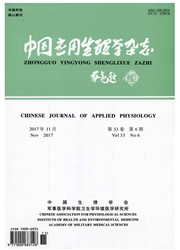

 中文摘要:
中文摘要:
目的:探讨脑源性神经营养因子(BDNF)对β淀粉样蛋白(Aβ)致大鼠突触功能障碍的保护作用。方法:36只健康雄性SD大鼠随机分为对照、Aβ25-35、BDNF、不同剂量BDNF(0.02μg,0.1μg,0.5μg)+Aβ25-35等六组(n=6)。实验采用电生理学手段,利用自制的海马给药装置和刺激/记录绑定电极引导和记录大鼠在体海马CA1区场兴奋性突触后电位(fEPSPs)和高频刺激(HFS)诱导的长时程增强(LTP)。结果:①海马CA1区注射Aβ25-35(2 nmol)不影响基础性fEPSPs,但能显著抑制LTP的诱导与维持,HFS后fEPSPs平均幅度较对照组明显降低(P〈0.01);②海马CA1区注射BDNF(0.1μg)不影响基础性fEPSPs,也不影响LTP的诱导与维持,HFS后fEPSPs平均幅度与对照组相比没有明显差异(P〉0.05);③与单独给予Aβ25-35相比,不同浓度的BDNF(0.1μg,0.5μg)与Aβ25-35合用组在HFS后0 min、30 min和60 min时的fEPSPs平均幅度均明显增加(P〈0.01),并具有一定的剂量依赖性,表明BDNF预处理可有效拮抗Aβ25-35引起的LTP抑制。结论:脑内注射BDNF能够预防和拮抗由Aβ25-35引起的海马LTP损伤,提示BDNF水平的上调有助于维持正常的突触可塑性并可能改善AD患者的学习记忆功能。
 英文摘要:
英文摘要:
Objective: To explore the effects of brain-derived neurotrophic factor(BDNF) pretreatment on β amyloid protein(Aβ)induced impairment of in vivo hippocampal long-term potentiation(LTP)in the CA1 region of rats.Methods: Thiyty-six adult male SD rats were randomly divided into six groups(n=6): control,Aβ25-35,BDNF,(0.02 μg,0.1 μg,0.5 μg) BDNF+Aβ25-35.A self-made hippocampal local drug delivery catheter and a parallel bound stimulating/recording electrode were used to deliver drugs/stimulation and record field excitatory post-synaptic potentials(fEPSPs) in the hippocampal CA1 region of rats.High-frequency stimulation(HFS) was used to induce in vivo LTP.Results: ① Aβ25-35(2 nmol) injection into CA1 region of rats did not affect the baseline fEPSPs,but inhibited the HFS-induced LTP significantly(P〈0.01).② Hippocampal CA1 injection of BDNF(0.1 μg) alone did not affect the baseline fEPSPs and HFS-induced LTP.③ Compared with Aβ25-35 alone group,the averaged amplitude of LTP in BDNF(0.1 μg and 0.5 μg) plus Aβ25-35 groups significantly increased at 0 min,30 min,and 60 min after HFS(P〈0.01),indicating that pretreatment with BDNF effectively protected against the Aβ25-35 induced depression of LTP in a dose-dependent manner.Conclusion: Intrahippocampal injection of BDNF can protect against the Aβ25-35-induced LTP impairment,suggesting that the up-regulation of BDNF in the brain could maintain the normal hippocampal synaptic plasticity and may contribute to the improvement of learning and memory in Alzheimer’s(AD) disease patients.
 同期刊论文项目
同期刊论文项目
 同项目期刊论文
同项目期刊论文
 期刊信息
期刊信息
